The Novelty of Thermo-Diffusion and Diffusion-Thermo, Slip, Temperature and Concentration Boundary Conditions on Magneto–Chemically Reactive Fluid Flow Past a Vertical Plate with Radiation
Abstract
:1. Introduction
2. Mathematical Model
3. Numerical Method
4. Results and Discussion
5. Conclusions
Author Contributions
Funding
Institutional Review Board Statement
Informed Consent Statement
Data Availability Statement
Acknowledgments
Conflicts of Interest
Abbreviations
| b | Slip parameter, [-] |
| Strength of magnetic field, [A m] | |
| Thermal Biot number, [-] | |
| Concentration Biot number, [-] | |
| c | Constant, [-] |
| Specific heat at constant pressure, | |
| [J K kg] | |
| Concentration susceptibility, [-] | |
| C | Species concentration, [kg m] |
| Fluid concentration, [mol m] | |
| Chemical reaction parameter, [-] | |
| D | Diffusion coefficient, [m s] |
| Dufour number, [-] | |
| Mass diffusivity, [m s] | |
| Thermophoretic diffusion coefficient, | |
| [m s] | |
| f | Dimensionless stream function, [-] |
| g | Gravitational acceleration, [m s] |
| Solutal Grashof number, [-] | |
| Thermal Grashof number, [-] | |
| Convective heat transfer coefficient, | |
| [W m K] | |
| Convective mass transfer coefficient, | |
| [m s] | |
| k | Thermal conductivity, [W m K] |
| K | Porosity parameter, [-] |
| Porous medium permeability, [m] | |
| Thermal diffusion ratio, [m s] | |
| Mean absorption coefficient, [-] | |
| M | Magnetic field parameter, [-] |
| Navier slip coefficient, [-] | |
| Prandtl number, [-] | |
| Q | Heat generation/absorption, [J] |
| Thermal radiation parameter, [-] | |
| Local Reynolds number, [-] | |
| Thermal Richardson | |
| number, [-] | |
| Solutal Richardson number, [-] | |
| S | Heat generation/absorption parameter, [-] |
| Schmidt number, [-] | |
| Soret number, [-] | |
| T | Temperature, [K] |
| Thermal diffusivity, [m s] | |
| Coefficient of thermal expansion, | |
| [K] | |
| Coefficient of solutal expansion, [-] | |
| Chemical reaction rate, [M s] | |
| Similarity variable, [-] | |
| Dimensionless temperature, [-] | |
| Kinematic viscosity, [m s] | |
| Dynamic viscosity, | |
| [Pa s] | |
| Density, [kg m] | |
| Electrical conductivity, [S m] | |
| Stefan-Boltzmann constant, | |
| [W m K] | |
| Dimensionless concentration, [-] | |
| Stream function, [kg m s] | |
| w | Condition at a wall, [-] |
| ∞ | Condition at free stream, [-] |
References
- Ferdows, M.; Khan, M.; Alam, M.; Sun, S. MHD mixed convective boundary layer flow of a nanofluid through a porous medium due to an exponentially stretching sheet. Math. Probl. Eng. 2012, 2012, 408528. [Google Scholar] [CrossRef]
- Yirga, Y.; Tesfay, D. Heat and mass transfer in MHD flow of nanofluids through a porous media due to a permeable stretching sheet with viscous dissipation and chemical reaction effects. Int. J. Mech. Aerosp. Ind. Mechatron. Manuf. Eng. 2015, 9, 709–716. [Google Scholar]
- Ullah, I.; Shafie, S.; Khan, I. Effects of slip condition and Newtonian heating on MHD flow of Casson fluid over a nonlinearly stretching sheet saturated in a porous medium. J. King Saud Univ. Sci. 2017, 29, 250–259. [Google Scholar] [CrossRef] [Green Version]
- Khan, N.S.; Islam, S.; Gul, T.; Khan, I.; Khan, W.; Ali, L. Thin film flow of a second grade fluid in a porous medium past a stretching sheet with heat transfer. Alex. Eng. J. 2018, 57, 1019–1031. [Google Scholar] [CrossRef]
- Cortell, R. MHD flow and mass transfer of an electrically conducting fluid of second grade in a porous medium over a stretching sheet with chemically reactive species. Chem. Eng. Process. 2007, 46, 721–728. [Google Scholar] [CrossRef]
- Malarselvi, A.; Bhuvaneswari, M.; Sivasankaran, S.; Ganga, B.; Abdul Hakeem, A.K. Effect of slip and convective heating on unsteady MHD chemically reacting flow over a porous surface with suction. Appl. Math. Comput. 2019, 357–365. [Google Scholar] [CrossRef]
- Seth, G.S.; Hussain, S.M.; Sarkar, S. Hydromagnetic natural convection flow with radiative heat transfer past an accelerated moving vertical plate with ramped temperature through a porous medium. J. Porous Media 2014, 17, 67–79. [Google Scholar] [CrossRef]
- Ellahi, R.; Bhatti, M.M.; Riaz, A.; Sheikholeslami, M. Effects of magnetohydrodynamics on peristaltic flow of Jeffrey fluid in a rectangular duct through a porous medium. J. Porous Media 2014, 17, 143–157. [Google Scholar] [CrossRef]
- Sivasankaran, S.; Niranjan, H.; Bhuvaneswari, M. Chemical reaction, radiation and slip effects on MHD mixed convection stagnation-point flow in a porous medium with convective boundary condition. Int. J. Numer. Method. Heat Fluid Flow 2017, 27, 454–470. [Google Scholar] [CrossRef]
- Abbas, A.; Shafqat, R.; Jeelani, M.B.; Alharthi, N. Significance of Chemical Reaction and Lorentz Force on Third-Grade Fluid Flow and Heat Transfer with Darcy–Forchheimer Law over an Inclined Exponentially Stretching Sheet Embedded in a Porous Medium. Symmetry 2022, 14, 779. [Google Scholar] [CrossRef]
- Rasool, G.; Shafiq, A.; Baleanu, D. Consequences of Soret–Dufour effects, thermal radiation, and binary chemical reaction on Darcy Forchheimer flow of nanofluids. Symmetry 2020, 12, 1421. [Google Scholar] [CrossRef]
- Ameer Ahamad, N.; Veera Krishna, M.; Chamkha, A.J. Radiation-absorption and Dufour effects on magnetohydrodynamic rotating flow of a nanofluid over a semi-infinite vertical moving plate with a constant heat source. J. Nanofluids 2020, 9, 177–186. [Google Scholar] [CrossRef]
- Ahammad, N.A.; Krishna, M.V. Numerical investigation of chemical reaction, Soret and Dufour impacts on MHD free convective gyrating flow through a vertical porous channel. Case Stud. Therm. Eng. 2021, 28, 101571. [Google Scholar] [CrossRef]
- Mallikarjuna, B.; Chamkha, A.J.; Vijaya, R.B. Soret and Dufour effects on double diffusive convective flow through a non-darcy porous medium in a cylindrical annular region in the presence of heat sources. J. Porous Media 2014, 17, 623–636. [Google Scholar] [CrossRef]
- Bhuvaneswari, M.; Eswaramoorthi, S.; Sivasankaran, S.; Hussein, A.K. Cross-diffusion effects on MHD mixed convection over a stretching surface in a porous medium with chemical reaction and convective condition. Eng. Trans. 2019, 67, 3–19. [Google Scholar] [CrossRef]
- Karthikeyan, S.; Bhuvaneswari, M.; Sivasankaran, S.; Rajan, S. Soret and Dufour effects on MHD mixed convection heat and mass transfer of a stagnation point flow towards a vertical plate in a porous medium with chemical reaction, radiation and heat generation. J. Appl. Fluid Mech. 2016, 9, 1447–1455. [Google Scholar] [CrossRef]
- Pal, D.; Mondal, H. Effects of Soret Dufour, chemical reaction and thermal radiation on MHD non-Darcy unsteady mixed convective heat and mass transfer over a stretching sheet. Commun. Nonlinear Sci. Numer. Simul. 2011, 16, 1942–1958. [Google Scholar] [CrossRef]
- Niranjan, H.; Sivasankaran, S.; Bhuvaneswari, M. Chemical reaction, Soret and Dufour effects on MHD mixed convection stagnation point flow with radiation and slip condition. Sci. Iran. 2017, 24, 698–706. [Google Scholar] [CrossRef] [Green Version]
- Bhattacharyya, K.; Layek, G.C.; Seth, G.S. Soret and Dufour effects on convective heat and mass transfer in stagnation-point flow towards a shrinking surface. Phys. Scr. 2014, 89, 095203. [Google Scholar] [CrossRef]
- Dhanalakshmi, M.; Jyothi, V.; Reddy, K.J. Soret and Dufour effects on MHD convective flow past a vertical plate through porous medium. J. Phys. Conf. Ser. 2019, 1344, 012008. [Google Scholar] [CrossRef]
- Postelnicu, A. Influence of a magnetic field on heat and mass transfer by natural convection from vertical surfaces in porous media considering Soret and Dufour effects. Int. J. Heat Mass Transf. 2004, 47, 1467–1472. [Google Scholar] [CrossRef]
- Rashad, A.; Chamkha, A. Heat and mass transfer by natural convection flow about a truncated cone in porous media with Soret and Dufour effects. Int. J. Numer. Method. Heat Fluid Flow 2014, 24, 595–612. [Google Scholar] [CrossRef]
- Das, M.; Mahanta, G.; Shaw, S.; Parida, S.B. Unsteady MHD chemically reactive double-diffusive Casson fluid past a flat plate in porous medium with heat and mass transfer. Heat Transf.-Asian Res. 2019, 48, 1761–1777. [Google Scholar] [CrossRef] [Green Version]
- Khan, A.S.; Nie, Y.; Shah, Z.; Dawar, A.; Khan, W.; Islam, S. Three-dimensional nanofluid flow with heat and mass transfer analysis over a linear stretching surface with convective boundary conditions. Appl. Sci. 2018, 8, 8112244. [Google Scholar] [CrossRef] [Green Version]
- Ullah, I.; Bhattacharyya, K.; Shafie, S.; Khan, I. Unsteady MHD mixed convection slip flow of Casson fluid over nonlinearly stretching sheet embedded in a porous medium with chemical reaction, thermal radiation, heat generation/absorption and convective boundary conditions. PLoS ONE 2016, 11, 0165348. [Google Scholar] [CrossRef] [Green Version]
- Krishna, M.V.; Ahammad, N.A.; Chamkha, A.J. Radiative MHD flow of Casson hybrid nanofluid over an infinite exponentially accelerated vertical porous surface. Case Stud. Therm. Eng. 2021, 27, 101229. [Google Scholar] [CrossRef]
- Lakshmi Devi, G.; Niranjan, H.; Sivasankaran, S. Effects of chemical reactions, radiation, and activation energy on MHD buoyancy induced nano fluidflow past a vertical surface. Sci. Iran. 2022, 29, 90–100. [Google Scholar] [CrossRef]
- Krishna, M.V.; Ahamad, N.A.; Chamkha, A.J. Radiation absorption on MHD convective flow of nanofluids through vertically travelling absorbent plate. Ain Shams Eng. J. 2021, 12, 3043–3056. [Google Scholar] [CrossRef]
- Bilal Ashraf, M.; Hayat, T.; Alsaedi, A. Mixed convection flow of Casson fluid over a stretching sheet with convective boundary conditions and Hall effect. Bound. Value Prob. 2017, 2017, 137. [Google Scholar] [CrossRef] [Green Version]
- Hayat, T.; Khan, M.I.; Waqas, M.; Alsaedi, A. Effectiveness of magnetic nanoparticles in radiative flow of Eyring-Powell fluid. J. Mol. Liq. 2017, 231, 126–133. [Google Scholar] [CrossRef]
- Shehzad, S.A.; Hayat, T.; Alsaedi, A. MHD flow of Jeffrey nanofluid with convective boundary conditions. J. Braz. Soc. Mech. Sci. Eng. 2015, 37, 873–883. [Google Scholar] [CrossRef]
- Abbasi, F.M.; Shehzad, S.A. Convective thermal and concentration transfer effects in hydromagnetic peristaltic transport with Ohmic heating. J. Adv. Res. 2017, 8, 655–661. [Google Scholar] [CrossRef] [PubMed]
- Ullah, I.; Alkanhal, T.A.; Shafie, S.; Nisar, K.S.; Khan, I.; Makinde, O.D. MHD slip flow of Casson fluid along a nonlinear permeable stretching cylinder saturated in a porous medium with chemical reaction, viscous dissipation, and heat generation/absorption. Symmetry 2019, 11, 531. [Google Scholar] [CrossRef] [Green Version]
- Makinde, O.D. Heat and mass transfer by MHD mixed convection stagnation point flow toward a vertical plate embedded in a highly porous medium with radiation and internal heat generation. Meccanica 2012, 47, 1173–1184. [Google Scholar] [CrossRef]

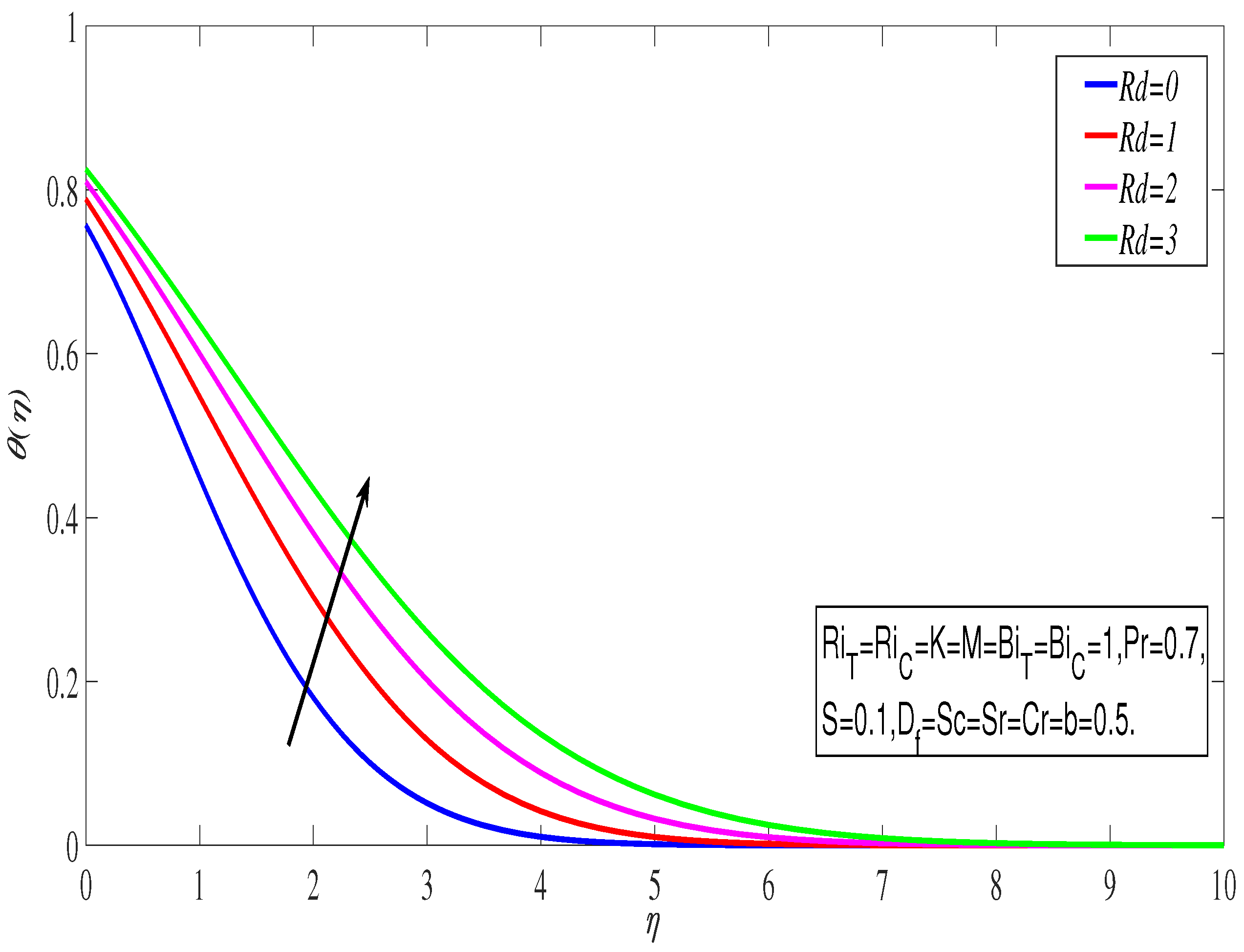


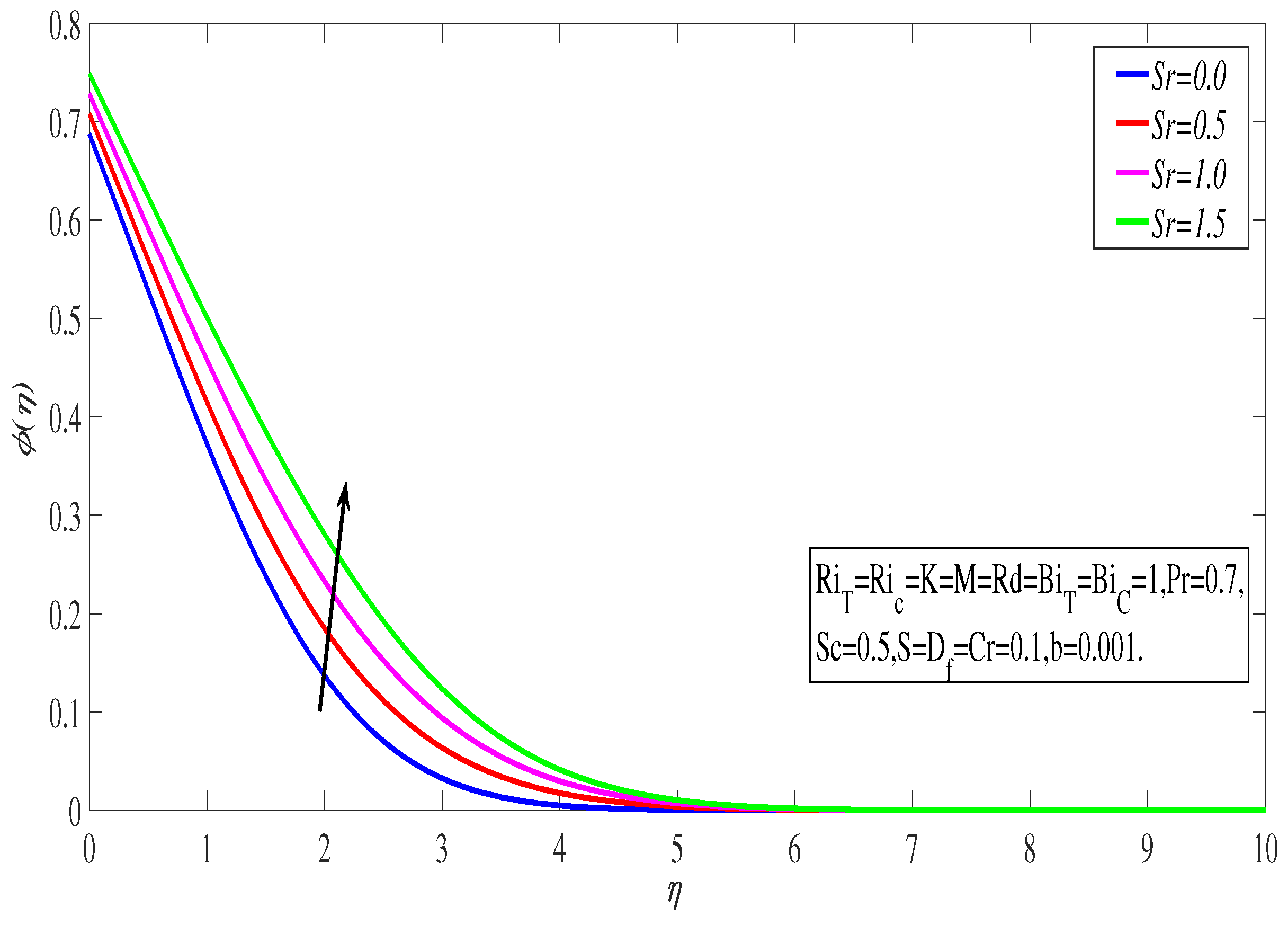
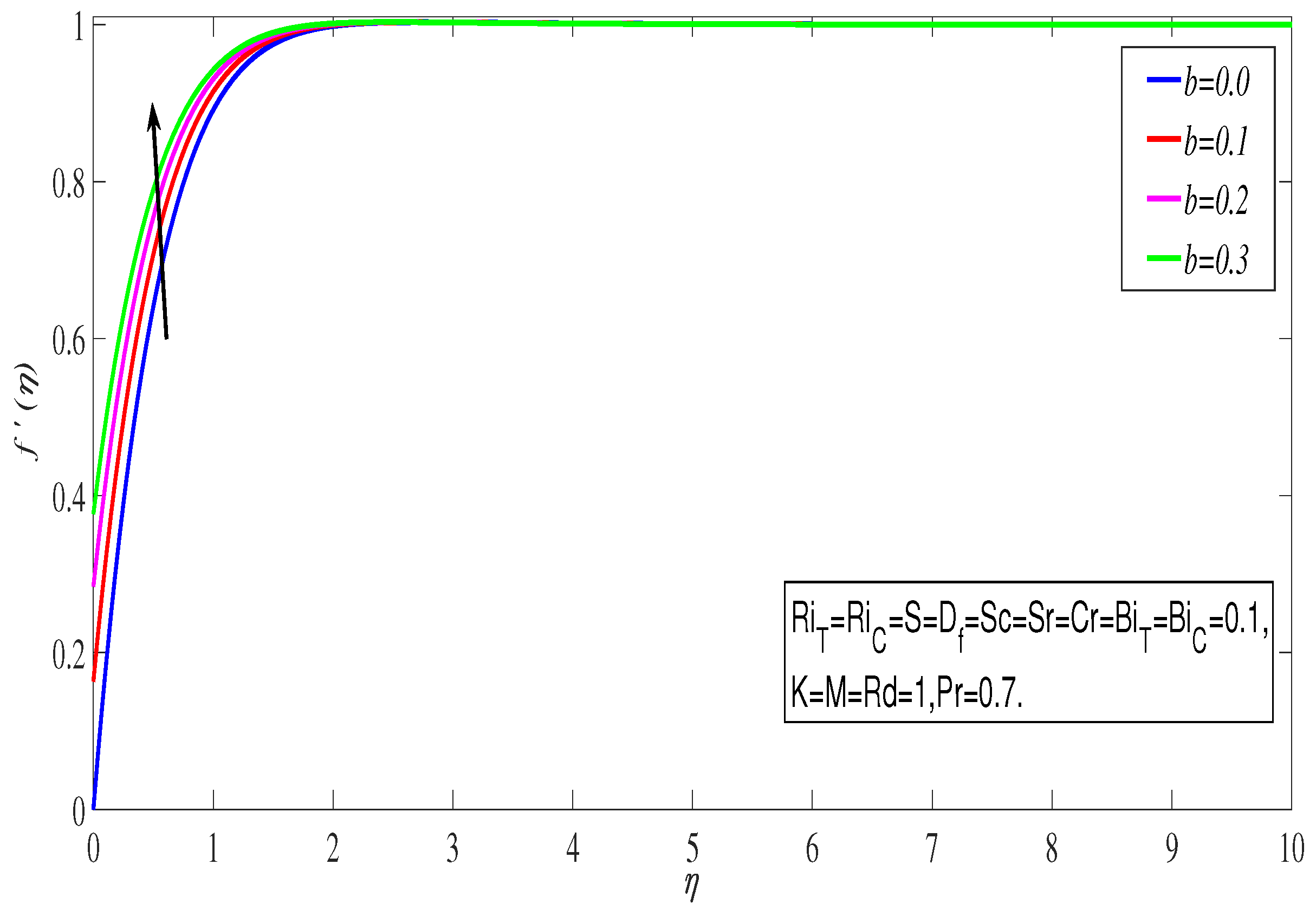
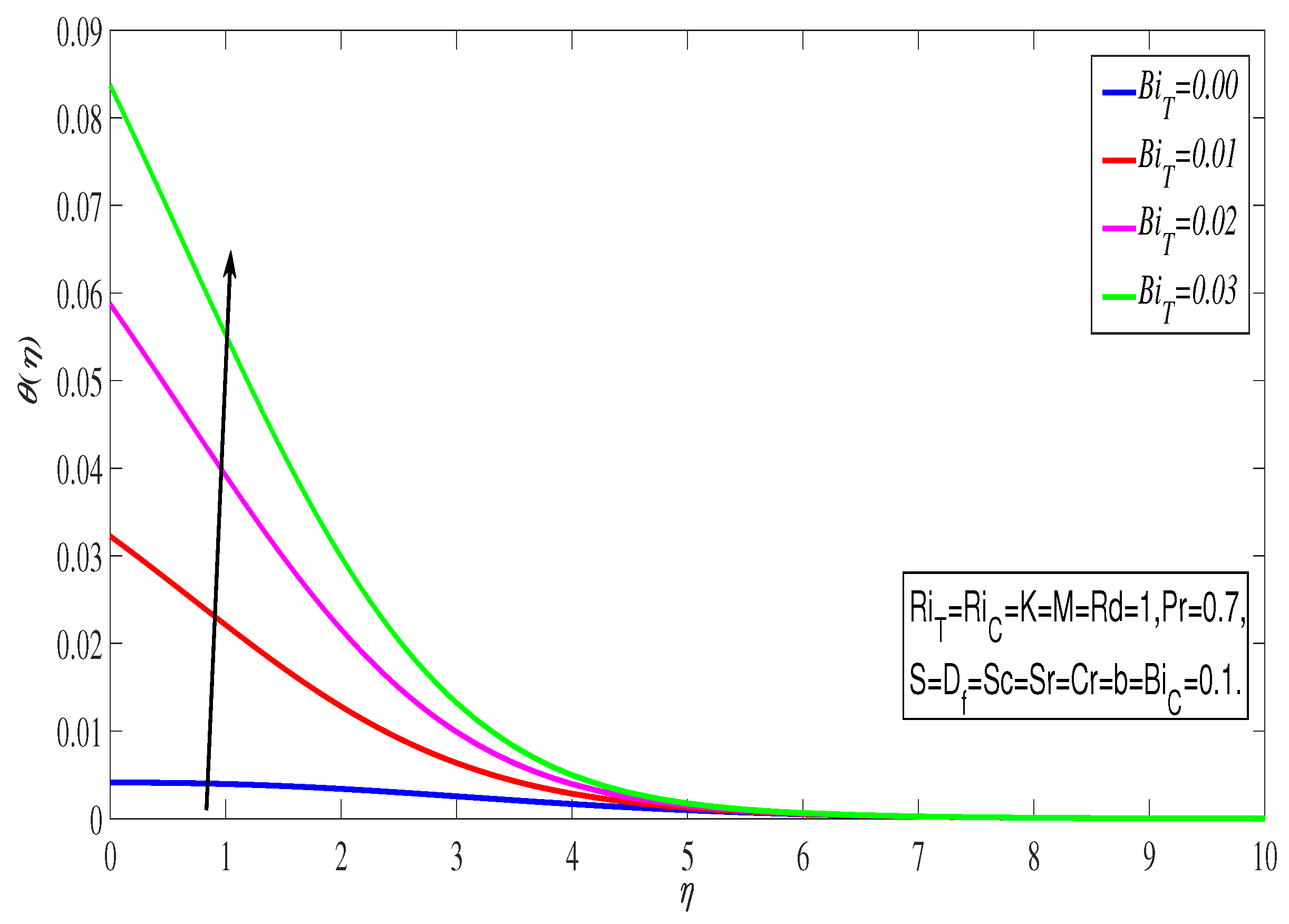


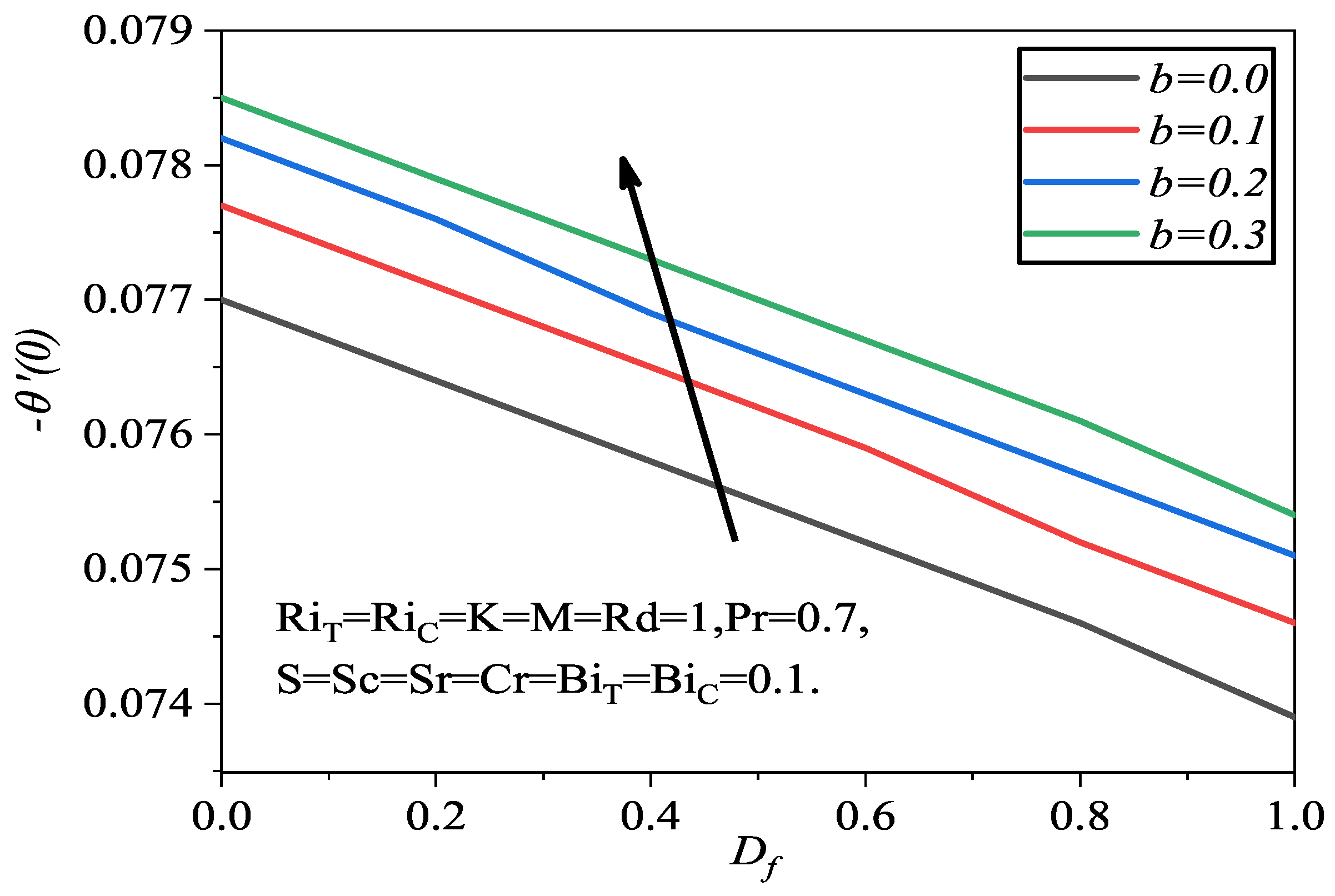
| S | Makinde [34] | Present Study | Makinde [34] | Present Study | Makinde [34] | Present Study |
|---|---|---|---|---|---|---|
| 0 | 1.9995 | 1.9995 | 0.6932 | 0.6393 | 0.4789 | 0.4789 |
| 1 | 2.1342 | 2.1719 | −0.0730 | −0.2463 | 0.4917 | 0.4950 |
| K | |
|---|---|
| 0.0 | 1.232588 |
| 0.5 | 1.419763 |
| 1.0 | 1.585331 |
| 1.5 | 1.735361 |
| 2.0 | 1.873527 |
| b | |||||
|---|---|---|---|---|---|
| 0.5 | 1.0 | 1.0 | 1.556363 | −0.560229 | 0.472827 |
| 1.0 | 1.037464 | −0.482620 | 0.462411 | ||
| 1.5 | 0.775455 | −0.448161 | 0.458227 | ||
| 2.0 | 0.618498 | −0.428815 | 0.456007 | ||
| 0.5 | 1.0 | 1.0 | 1.556363 | −0.560229 | 0.472827 |
| 2.0 | 1.484332 | −0.560190 | 0.456163 | ||
| 3.0 | 1.459595 | −0.557169 | 0.449791 | ||
| 4.0 | 1.447192 | −0.555056 | 0.446464 | ||
| 0.5 | 1.0 | 1.0 | 1.556363 | −0.560229 | 0.472827 |
| 2.0 | 1.609949 | −0.593423 | 0.570065 | ||
| 3.0 | 1.632601 | −0.607625 | 0.612868 | ||
| 4.0 | 1.645140 | −0.615530 | 0.636996 |
Publisher’s Note: MDPI stays neutral with regard to jurisdictional claims in published maps and institutional affiliations. |
© 2022 by the authors. Licensee MDPI, Basel, Switzerland. This article is an open access article distributed under the terms and conditions of the Creative Commons Attribution (CC BY) license (https://creativecommons.org/licenses/by/4.0/).
Share and Cite
Lakshmi Devi, G.; Niranjan, H. The Novelty of Thermo-Diffusion and Diffusion-Thermo, Slip, Temperature and Concentration Boundary Conditions on Magneto–Chemically Reactive Fluid Flow Past a Vertical Plate with Radiation. Symmetry 2022, 14, 1496. https://doi.org/10.3390/sym14081496
Lakshmi Devi G, Niranjan H. The Novelty of Thermo-Diffusion and Diffusion-Thermo, Slip, Temperature and Concentration Boundary Conditions on Magneto–Chemically Reactive Fluid Flow Past a Vertical Plate with Radiation. Symmetry. 2022; 14(8):1496. https://doi.org/10.3390/sym14081496
Chicago/Turabian StyleLakshmi Devi, Gavireddy, and Hari Niranjan. 2022. "The Novelty of Thermo-Diffusion and Diffusion-Thermo, Slip, Temperature and Concentration Boundary Conditions on Magneto–Chemically Reactive Fluid Flow Past a Vertical Plate with Radiation" Symmetry 14, no. 8: 1496. https://doi.org/10.3390/sym14081496






